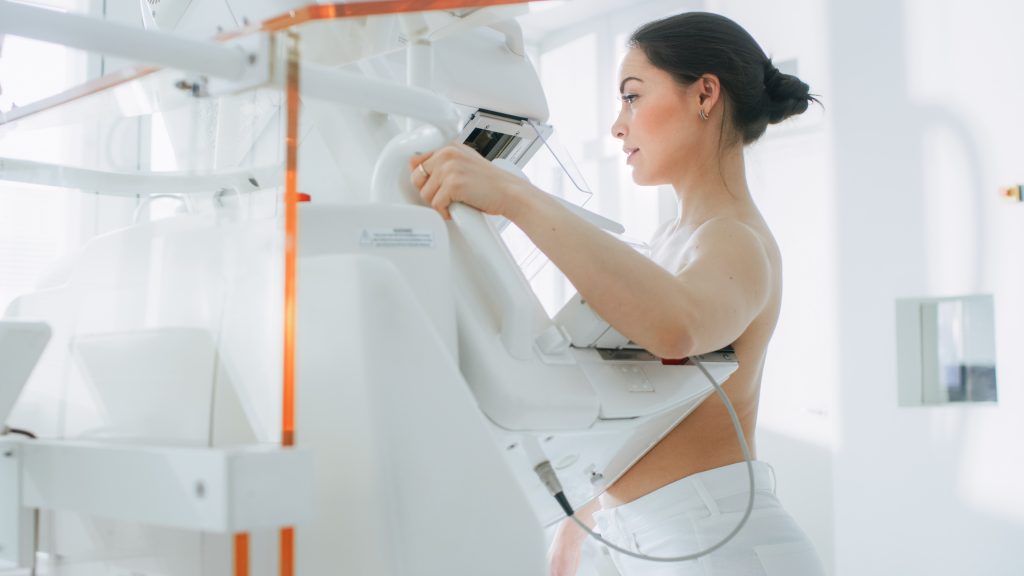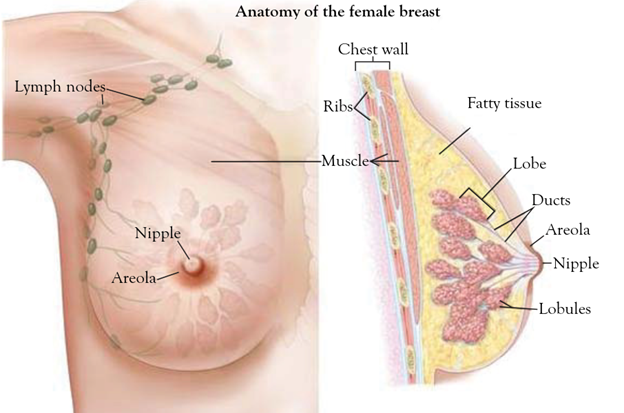Breast Cancer and Its Treatment
What is breast cancer?
Breast cancer is a disease in which the body’s own breast tissue cells mutate, stop performing its usual functions and begin to divide rapidly in an uncontrolled fashion. This clump of rapidly dividing cells then begins to form a lump in the breast tissue. This clump of cells can place pressure on and cause problems in the normal function of the surrounding breast tissue.

One of the reasons this can be dangerous is that some of these mutant cells can break free from the original clump (tumor) and migrate through the body’s lymph and blood circulation system and then set up residence in a different place in the body. This is called metastasis. The cell in the new place in the body then proceeds to divide rapidly and out of control in this new place, causing problems by putting pressure on existing normal tissues, eventually inhibiting function of the tissues in the new place. The cells in the new place can also migrate from there to other places in the body, repeating the cycle.
Breast Cancer Statistics
- In the US, 1 in 8 women, or about 13%, will develop invasive (spread into surrounding breast tissue) breast cancer over the course of their lifetime.
- In the year 2021, it is projected that 281,550 new cases of invasive breast cancer will be diagnosed in women in the U.S., along with 49,290 new cases of non-invasive (in situ) breast cancer.
- Men can also get breast cancer, but the incidence is lower than in women, about 1 in 833, or about 2650 new invasive cases expected in 2021.
- Death rates have remained the same in women under 50 since 2007, but have been dropping in women over 50 by 1% per year from 2018-2018.
- Breast cancer is the second leading cause of death from cancer for American women, following lung cancer.
How is breast cancer diagnosed?
The most common screening tool for breast cancer is the mammogram, a specialized type of x-ray which can show abnormalities in the breast tissue. Yearly mammograms are recommended starting at age 40 until age 54 if at normal risk. After age 55, mammograms are recommended every 2 years, to continue as long as the personal life expectancy is ten years or greater (Please consult with your own physician in regards to their recommendations, taking into account your own personal and family history risk). Of course the doctor may alter the frequency of screening based on personal medical history and circumstances. If a lump or mass is found, often an ultrasound of the lump is performed. If based on the mammogram and ultrasound, there is suspicion that it may be cancer, a biopsy is performed to examine the tissue from the lump directly. In the biopsy, a small piece of tissue is removed from the lump and examined under the microscope. This may be done through a needle biopsy or surgically, depending on the location of the lump. Until the biopsy is done and analyzed, it is not known for sure if it is cancer or something else. The doctors may suspect cancer, but the biopsy is considered definitive. If there are any suspicious lumps in the lymph nodes surrounding the breast, these may also be biopsied to evaluate if the cancer has spread to the lymph nodes. Sometimes a CT scan or MRI may also be ordered if they need more clear imaging of the area with the tumor. The doctor may also order a PET scan to see if there is cancer anywhere else in the body.
How is breast cancer treated?
Breast cancer is treated through three main treatments, surgery, chemotherapy, and radiation. The goal of surgery is to remove the entire tumor, as well as any involved lymph nodes or lymph nodes at risk (if indicated). Sometimes chemotherapy is given before surgery and sometimes after, depending on the clinical situation. Radiation therapy is usually given after completion of surgery and chemotherapy (if indicated). In some early stage cases no chemotherapy is indicated, so surgery is then followed by radiation therapy. Each patient’s case is very unique and treatment is determined based on discussion among the surgeon, medical oncologist (doctor who administers chemotherapy) and radiation oncologist (doctor who administers radiation therapy). When these physicians are gathered to discuss your case this is usually referred to a tumor board. Please consult your own physicians in regards to optimal treatment for your own case.
Chemotherapy uses various agents toxic to the particular cancer type, given usually in the bloodstream in an attempt to kill off the targeted cancer cells. Radiation uses high-voltage radiation beams focused on the area of the tumor to kill the tumor cells. Treatment of each case of breast cancer is individualized using many factors, including genetic markers in the cancer cells, age, height/weight of the patient, whether cancer is invasive or metastatic, size of the tumor, and the presence of hormone receptor cells in the cancer cells.
Types of radiation treatment
External beam radiation therapy- this is what most people think of when they think of radiation- a machine outside the body focuses a beam of radiation to the desired area receiving treatment, such as the entire breast. Treatment with External beam radiation can range from 3 weeks to 6 weeks of daily treatment (Monday through Friday).
Accelerated partial breast irradiation (APBI) a type of radiation which gives a larger radiation dose over a shorter time to only one part of the breast instead of the to the entire breast. This can be done either via external beam or via brachytherapy (see below). Treatments via APBI are usually done in 5 days.
Proton therapy is a specialized type of radiation which uses a highly focused charged beam of energy to provide high dose radiation to the target area minimizing exit dose to tissues nearby.
Brachytherapy is a type of radiation where an implantable device is inserted into the tumor bed. Radioactive seeds are then inserted into the device and give high doses of radiation in a short period of time. Traditionally this has been done via twice daily treatments over 5 days.
To see what type of radiation therapy best fits your need, schedule a consultation today with Dr. Mani Akhtari to assess how most effectively your tumor can be treated while minimizing any side effects. Dr. Akhtari utilizes personalized radiation plans, custom made to best suit each patient’s unique situation. His office is located in Fort Worth, Texas and he treats patients from all over the Dallas-Fort Worth Metroplex. He is a member of Texas Oncology group, which has a dedicated network of radiation oncologists, medical oncologists, as well as breast surgeons.
Diagram of the female breast courtesy of Breast Cancer: Medical Treatment, Side Effects, and Complementary Therapies

Notice how the lobules make up the lobes in a breast, this is where the milk is made. The milk then travels down the ducts to the nipple where the milk comes out. Also notice how certain lymph nodes are connected to certain lobes of the breast, providing nourishment and drainage to the cells in that area. This connection is why the lymph nodes are often the first place where a loose cancer cell can travel to and start growing, forming a new area with the cancer.